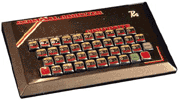|
Name
|
Image
|
Date
|
Notes
|
|
CIP-03
|
|
1983?
|
Clone
of the ZX
Spectrum, produced by Electronica of Romania. |
|
Composite
|

(Larger
image - 77Kb)
|
1983? |
Apparently
a generic clone of the ZX
Spectrum, utilising a Zilog Z80A with 16Kb
of RAM and a copy of the original Ferranti ULA. Produced
in Slovakia. |
|
Didaktik Gama
|
|
1987-89
|
A heavily
re-engineered Spectrum
clone from Slovakia (prior to the breakup of Czechoslovakia).
Produced by Didaktik
Skalica, the Gama was issued in three versions
in 1987, 1988 and 1989, each of the subsequent versions
essentially fixing problems in the precessor machines.
All models have 80Kb RAM and a 16Kb ROM, using the original
Ferranti ULA, a Z80A CPU and Russian memory chips. Because
of the different hardware setup, the machine is not 100%
Spectrum-compatible. |
|
Didaktik M 90/91
|

More
images
|
1990/91
|
A later
development of the Didaktik Gama, likewise produced in
the then Slovak Republic. Although it comes with 64Kb
RAM, it actually only uses 48Kb. It has twin joystick
ports (Kempston and Sinclair), a parallel interface and
monitor output. Two versions of the Didaktik M were produced,
dubbed the 90 and 91 after their years of origin. A three-channel
stereo sound interface was developed for the machine. |
|
Didaktik Kompakt
|
|
1991
|
A further development of the Didaktik
M, featuring a 3.5" floppy disk drive which uses
a non-standard 840Kb format. Its hardware is otherwise
the same as the Didaktik M. Remarkably, both the Didaktik
M and Kompakt are still available today. The two machines
are now manufactured by Sintech of Germany and sell
for about EUR50 - EUR200 (see http://www.sintech-shop.de
for details).
|
|
Elwro 600 Jr
|
|
?
|
Polish Spectrum
clone. Appears to be fairly similar to the original
Spectrum, but comes with a full-size keyboard with a
flip-up paper holder (!).
|
|
Elwro 800-2 Jr
|
|
?
|
As above, with floppy disk drive and
a version of CP/M.
|
|
HC-85
|
|
?
|
Romanian-produced clone
of the Spectrum,
produced by ICE-Felix. (The HC apparently stands for
"Home Computer").
|
|
HC-91
|
|
?
|
As above, but with a
better PC-style keyboard.
|
|
HCX
|
|
1987
|
Spectrum
clone from Magdeburg in East Germany. It replicates
the original Sinclair ULA using two standard ICs (U885
and U887) but this unfortunately causes significant
compatibility problems.
|
|
HT 3080C
|
|
1986
|
Hungarian copy of the Spectrum,
produced by Híradástechnikai Szövetkezet.
Comes with 64Kb RAM and 32Kb ROM; also has an AY sound
chip, similar to but not compatible with that in the
Spectrum
128. Most unusually, the HT 3080C was a
clone of both the Spectrum and the TRS-80, and also
had a Commodore serial port compatible with C64 peripherals
(such as the C1541 disk drive). The machine's peculiar
specifications were due to it having been designed
for the school market with backward compatibility
with the company's previous products, the HT 1080Z
and HT 2080Z (TRS-80 clones), in mind.
|
|
Mistrum
|
|
?
|
Clone of the Spectrum
produced in the Czech Republic, prior to the breakup
of Czechoslovakia.
|
|
Spectral
|
|
1988
|
Followup to the HCX (see
above), this compatible East German Spectrum
clone came in two models with 64Kb or 128Kb RAM and
a built-in joystick interface as standard. It was sold
in kit form by Hübner
Elektronik of Erfurt.
|
|
Unipolbrit 2086
|
|
?
|
A now very rare clone
of the TS
2068. The name is said to be a contraction
of "United Polish British".
Came with 64Kb RAM and a modified ROM, plus a separate
Spectrum 48K ROM (presumably to provide compatibility),
and a parallel printer port added where the right-hand
joystick port would have been on a real TS 2068.
|